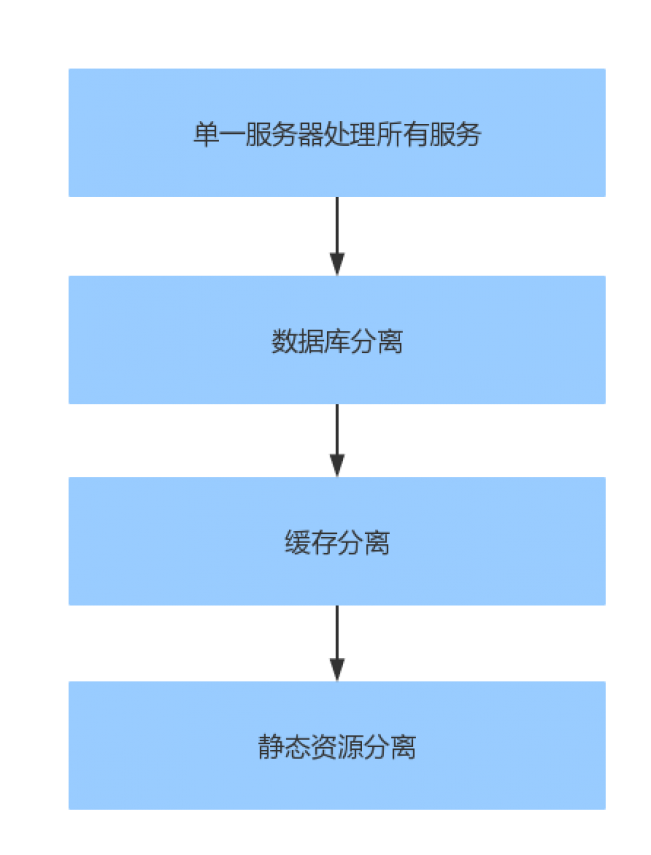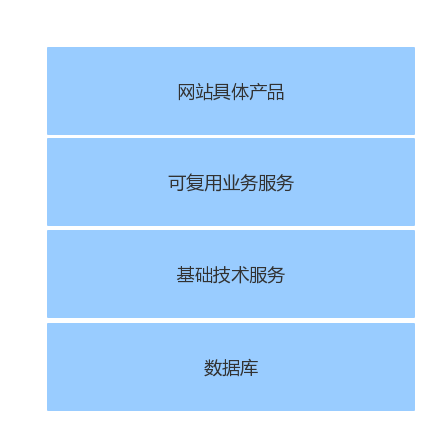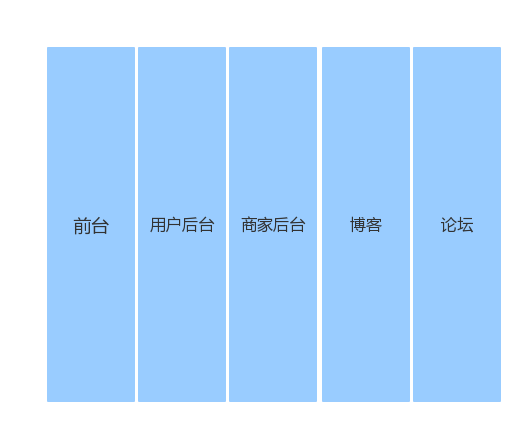Scalability design of website architecture
In the early days of website development, we are accustomed to writing all codes into one project.
Front-end, back-end, cache, database, static resources...etc.
Physical separation of website systems
Slowly the system will become larger and larger, and it will obviously need to face high concurrent access by a large number of users and store massive data.
Many user requests cannot be completed on one server.
A lot of cached data and database data cannot be completed on one server.
At this time, the scalability architecture of the website becomes particularly important.
As shown below.

Principle
We assemble multiple servers into a whole to provide services together. By continuously adding servers to the cluster, we can alleviate the rising pressure of concurrent user access and the growing demand for data storage.
The main criterion for measuring the scalability of an architecture:
How easy it is to add new servers to the cluster.
When adding a new server, can it provide the same service as the original server?
Is there a limit to the total number of servers that can be accommodated in the cluster?
Application Server Cluster
As long as no data is saved on the server, all servers are equal, and servers can be added to the cluster through load balancing devices.
Relational Database Cluster (MYSQL)
The cluster scalability solution of the relational database must be implemented outside the database. Servers with multiple data deployed are formed into a cluster through routing partitioning and other means.
For example: Mysql, etc.
Non-relational database cluster (NOSQL)
Non-relational databases are inherently prepared for massive databases, so they support scalability very well.
For example: Redis, Memcache, etc.
Cache Server Cluster
Adding new servers may cause the cache routing to become invalid, which in turn makes most of the cached data in the cluster inaccessible.
Before deployment, the cache routing algorithm needs to be improved to ensure the accessibility of cached data.
Static resource server cluster
Resources such as CSS, JS, Img, etc. are deployed to the server cluster to reduce traffic and increase page rendering speed.
Vertical separation of the website
Separate and deploy different parts of the business processing process to achieve system scalability.
As shown below.

Horizontal separation of the website
Separate deployment of different business modules to achieve system scalability.
As shown below.

A single function scales through the cluster size.
Separating and deploying different functions can achieve a certain degree of scalability, but as the number of website visits gradually increases, even an independent deployment of a single server separated to the latest granularity cannot meet the requirements of business scale.
Therefore, a server cluster must be used, that is, the same service is deployed on multiple servers to form a cluster for overall external services.
For example: search function.
If a server can provide 1,000 request services per second, if the website is at peak period, the number of search visits per second will be 10,000.
Then, you need to deploy 10 servers to form a cluster.
Similarly, this situation will also occur with cache servers.
In fact, when calculating the cluster size of a service, you need to consider its impact on availability, performance and the impact of associated service clusters.
Summary
Cluster scalability can be divided into application server cluster scalability and data server cluster scalability.
Due to the different management of data status, the technical implementation of these two clusters is also very different.
Everyone, you can conduct in-depth research based on each specific architectural design.
The article is borrowed from the book "Technical Architecture of Large Websites".

Hot AI Tools

Undresser.AI Undress
AI-powered app for creating realistic nude photos

AI Clothes Remover
Online AI tool for removing clothes from photos.

Undress AI Tool
Undress images for free

Clothoff.io
AI clothes remover

Video Face Swap
Swap faces in any video effortlessly with our completely free AI face swap tool!

Hot Article

Hot Tools

Notepad++7.3.1
Easy-to-use and free code editor

SublimeText3 Chinese version
Chinese version, very easy to use

Zend Studio 13.0.1
Powerful PHP integrated development environment

Dreamweaver CS6
Visual web development tools

SublimeText3 Mac version
God-level code editing software (SublimeText3)

Hot Topics
 1386
1386
 52
52
 PHP 8.4 Installation and Upgrade guide for Ubuntu and Debian
Dec 24, 2024 pm 04:42 PM
PHP 8.4 Installation and Upgrade guide for Ubuntu and Debian
Dec 24, 2024 pm 04:42 PM
PHP 8.4 brings several new features, security improvements, and performance improvements with healthy amounts of feature deprecations and removals. This guide explains how to install PHP 8.4 or upgrade to PHP 8.4 on Ubuntu, Debian, or their derivati
 How To Set Up Visual Studio Code (VS Code) for PHP Development
Dec 20, 2024 am 11:31 AM
How To Set Up Visual Studio Code (VS Code) for PHP Development
Dec 20, 2024 am 11:31 AM
Visual Studio Code, also known as VS Code, is a free source code editor — or integrated development environment (IDE) — available for all major operating systems. With a large collection of extensions for many programming languages, VS Code can be c
 7 PHP Functions I Regret I Didn't Know Before
Nov 13, 2024 am 09:42 AM
7 PHP Functions I Regret I Didn't Know Before
Nov 13, 2024 am 09:42 AM
If you are an experienced PHP developer, you might have the feeling that you’ve been there and done that already.You have developed a significant number of applications, debugged millions of lines of code, and tweaked a bunch of scripts to achieve op
 How do you parse and process HTML/XML in PHP?
Feb 07, 2025 am 11:57 AM
How do you parse and process HTML/XML in PHP?
Feb 07, 2025 am 11:57 AM
This tutorial demonstrates how to efficiently process XML documents using PHP. XML (eXtensible Markup Language) is a versatile text-based markup language designed for both human readability and machine parsing. It's commonly used for data storage an
 Explain JSON Web Tokens (JWT) and their use case in PHP APIs.
Apr 05, 2025 am 12:04 AM
Explain JSON Web Tokens (JWT) and their use case in PHP APIs.
Apr 05, 2025 am 12:04 AM
JWT is an open standard based on JSON, used to securely transmit information between parties, mainly for identity authentication and information exchange. 1. JWT consists of three parts: Header, Payload and Signature. 2. The working principle of JWT includes three steps: generating JWT, verifying JWT and parsing Payload. 3. When using JWT for authentication in PHP, JWT can be generated and verified, and user role and permission information can be included in advanced usage. 4. Common errors include signature verification failure, token expiration, and payload oversized. Debugging skills include using debugging tools and logging. 5. Performance optimization and best practices include using appropriate signature algorithms, setting validity periods reasonably,
 PHP Program to Count Vowels in a String
Feb 07, 2025 pm 12:12 PM
PHP Program to Count Vowels in a String
Feb 07, 2025 pm 12:12 PM
A string is a sequence of characters, including letters, numbers, and symbols. This tutorial will learn how to calculate the number of vowels in a given string in PHP using different methods. The vowels in English are a, e, i, o, u, and they can be uppercase or lowercase. What is a vowel? Vowels are alphabetic characters that represent a specific pronunciation. There are five vowels in English, including uppercase and lowercase: a, e, i, o, u Example 1 Input: String = "Tutorialspoint" Output: 6 explain The vowels in the string "Tutorialspoint" are u, o, i, a, o, i. There are 6 yuan in total
 Explain late static binding in PHP (static::).
Apr 03, 2025 am 12:04 AM
Explain late static binding in PHP (static::).
Apr 03, 2025 am 12:04 AM
Static binding (static::) implements late static binding (LSB) in PHP, allowing calling classes to be referenced in static contexts rather than defining classes. 1) The parsing process is performed at runtime, 2) Look up the call class in the inheritance relationship, 3) It may bring performance overhead.
 What are PHP magic methods (__construct, __destruct, __call, __get, __set, etc.) and provide use cases?
Apr 03, 2025 am 12:03 AM
What are PHP magic methods (__construct, __destruct, __call, __get, __set, etc.) and provide use cases?
Apr 03, 2025 am 12:03 AM
What are the magic methods of PHP? PHP's magic methods include: 1.\_\_construct, used to initialize objects; 2.\_\_destruct, used to clean up resources; 3.\_\_call, handle non-existent method calls; 4.\_\_get, implement dynamic attribute access; 5.\_\_set, implement dynamic attribute settings. These methods are automatically called in certain situations, improving code flexibility and efficiency.




